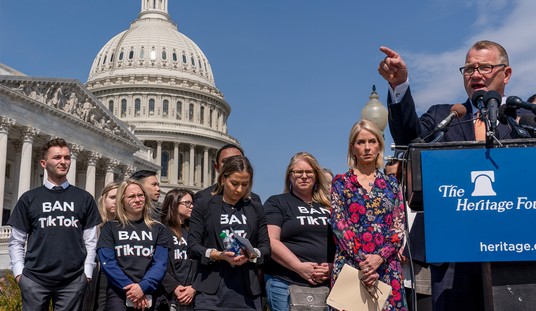Every study of asymptomatic carriers is bugged by the same question. How many are asymptomatic and how many are pre-symptomatic? How many ended up never developing symptoms during the course of their illness and how many happened to not be experiencing symptoms on the day they were tested but did so later?
A prison study would be a perfect candidate for that sort of retrospective analysis since the sample isn’t going anywhere. A month from now, go back to all the asymptomatic prisoners and find out how many never had a fever, a cough, trouble breathing, and so on after they were tested.
Assuming 96 percent ends up being accurate, though, that’s a mind-boggling, bombshell number, literally more than twice the percentage of estimated asymptomatics I’ve run across in reading about other populations. And I don’t mean city populations; I mean “captive” populations, forced into close quarters in confined spaces like prisoners are. As of three days ago “about 50 percent” of sailors on the USS Theodore Roosevelt who’d tested positive were asymptomatic. Aboard the Diamond Princess, the number of asymptomatics was similar, 46.5 percent. Prisons are seeing twice that rate, it seems. Why?
Also mind-boggling is the number of prisoners who’ve tested positive, period. At the Marion Correctional Institution in Ohio, 88 percent of the population was infected. At prisons in Michigan and North Carolina, well over half of those tested were positive. Across prison systems in four states, per the numbers provided below, 70 percent had COVID-19. The virus is spreading through these facilities like wildfire — but without much of a human toll, thankfully. If you’re still clinging to the Oxford model’s theory that much of the world has already been infected without knowing it despite the discouraging news from NYC a few days ago, these prison numbers are the most heartening news you’ve had in weeks.
In four state prison systems — Arkansas, North Carolina, Ohio and Virginia — 96% of 3,277 inmates who tested positive for the coronavirus were asymptomatic, according to interviews with officials and records reviewed by Reuters. That’s out of 4,693 tests that included results on symptoms…
After a recent spike in cases at the Neuse Correctional Institution in Goldsboro, North Carolina, state correctional officials tested all 723 prisoners last week. Of the 444 who were infected by the virus, 98% were asymptomatic, the state’s department of public safety said. One inmate has died at the prison.
Similarly, mass testing at two Arkansas prisons — the Cummins Unit in the city of Grady and the Community Correction Center in the state capital Little Rock — found 751 infected inmates, almost all of them asymptomatic, the state corrections department said. It did not provide the total number of inmates who were tested.
One question arising from those numbers seems like it has an easy answer. Namely, why are rates of infection so much higher in prisons than they were among the “captive” populations on the Theodore Roosevelt and the Diamond Princess? Presumably it’s due to simple hygiene. Sailors and cruise passengers enjoy more sanitary conditions than prisoners do, with more opportunities to keep themselves clean. The other question is harder to answer: Why is the rate of asymptomatic infection so much higher in prison than on those ships, or across the general population? There’s no obvious explanation for why prisoners should be more resistant to the disease. To the contrary, prison living isn’t conducive to good health. Many prisoners are older too, and so they should be more susceptible to serious complications. And yet — 96 percent asymptomatic.
Let’s do some math, starting with the assumption that U.S. cities are testing only people who are showing symptoms. That may be an overstatement but it’s probably a mild one since tests are scarce and doctors don’t want to waste them on those who are less likely to have the disease. There are 150,000 confirmed cases of COVID-19 in New York City; if the ratio of asymptomatic to symptomatic carriers there is the same as it is in the prisons described by Reuters — 24 to one — then we’d expect 3.6 million New Yorkers, or 43 percent of the city, to have had coronavirus. The recent antibody tests reported by Andrew Cuomo indicate a number half that amount, 21.2 percent, which means the true ratio is more like 12 to one. Similarly, the latest antibody testing from Miami-Dade County in Florida finds that six percent there had COVID antibodies in their blood: “The researchers say they are 95% certain that the true amount of infection lies between 4.4% and 7.9% of the population, with 6% representing the best estimate.” There are around 11,000 confirmed cases in Miami-Dade; the prison ratio of 24 to one would lead us to expect 250,000 people or so have had the virus. In reality, six-percent prevalence in Miami-Dade would mean 165,000 people have had it, a ratio closer to 15 to one.
The problem with guesstimating based on confirmed cases is that different cities are testing at different rates. The confirmed case count in a city like New York that’s testing a lot might be a more accurate reflection of symptomatic cases than the case count in a city that isn’t testing much, where even some symptomatic cases aren’t being tested. It seems like we can safely say that there are *many* more asymptomatic cases than symptomatic ones out there, possibly on the order of 10 to one or better. But if it’s much less than 24 to one, we’re left with a mystery as to why so many prisoners are unaffected.
The high rate of asymptomatics in prisons may also mean less for the fatality rate than we think. Reuters notes in its report that “In the seven state prison systems conducting mass tests, 49 inmates have died” bu it doesn’t say how many prisoners total have tested positive across those seven states. If you want to guesstimate 5,000, that would mean a fatality rate of one percent, in line with some of the grimmer estimates of COVID’s deadliness. If you want to assume 10,000 are positive, that’s a fatality rate of 0.5 percent, a number suggested by some experts.
Speaking of grim estimates, it looks like we’re going to overshoot the famous IHME model’s forecast of deaths in the U.S. from coronavirus. A few weeks ago IHME lowered its projections from 80,000 deaths to 60,000 by August 4, a bit of good news that was seized on by the White House. In reality we passed 50,000 deaths last night, with five days left to go in April and no signs of a steep drop in the epidemic curve that might sharply reduce daily deaths anytime soon. IHME’s death projections have now been revised upward to 67,000, in fact. Researchers who doubted their methodology are now taking the opportunity to say “I told you so.”
“The IHME model is an odd duck in the pool of mathematical models,” said Gregg Gonsalves, an epidemiologist at the Yale School of Medicine. “I fear the White House is looking for data that tells them a story they want to hear, and so they look to the model with the lowest projection of death.”
At the center of those concerns is a key element, the IHME model’s critics say. The projection makes no attempt to account for the virus’ defining characteristics, such as how easily it spreads or how long someone can be infected before they show symptoms.
Instead, it relies on data from cities already hit by the coronavirus, including in Italy and China, and matches the U.S. to a similar curve…
Privately, two people close to the administration’s response effort acknowledged that the death toll is likely to grow into the 70,000 and perhaps 80,000 range — and that’s assuming there isn’t a second wave of outbreaks in the fall.
The director of IHME told Politico that they’ll probably revise their death projections upward again soon because they had “presumed, perhaps naively, that given the magnitude of the epidemic, most states would stick to their social distancing until the end of May” and that’s clearly not going to happen. As for why their initial forecast was too optimistic, I’ll leave you with the short take below from Scott Gottlieb. The famous “curve” with which we’re all familiar assumes exponential growth upward as the epidemic rages and then a similarly exponential decline as the contagion abates. That may be how it works when transmission is being curtailed by herd immunity but it’s not necessarily how it works when it’s being curtailed through sustained social distancing. In those circumstances the right side of the curve may be really more of a gently sloping downward ramp. It’ll take much longer to reach the bottom than we hoped.
Some models like closely watched IHME predict a symmetric epidemic curve, where slope of decline is proportional to slope of the rise. That was mostly the case in China, but not in Italy. And it won't be the case in U.S. Our decline will be far more gradual, similar to Italy. 2/n pic.twitter.com/PjQ5bQ4RNs
— Scott Gottlieb, MD (@ScottGottliebMD) April 26, 2020
We all want this to be over. And things are mostly trending in right direction. But we're still very much in the thick of the epidemic. What we do over next few weeks will determine if we can get this wave more firmly behind us, or whether covid remains a combustible threat. 4/n pic.twitter.com/SvcpG6uSRg
— Scott Gottlieb, MD (@ScottGottliebMD) April 26, 2020









Join the conversation as a VIP Member